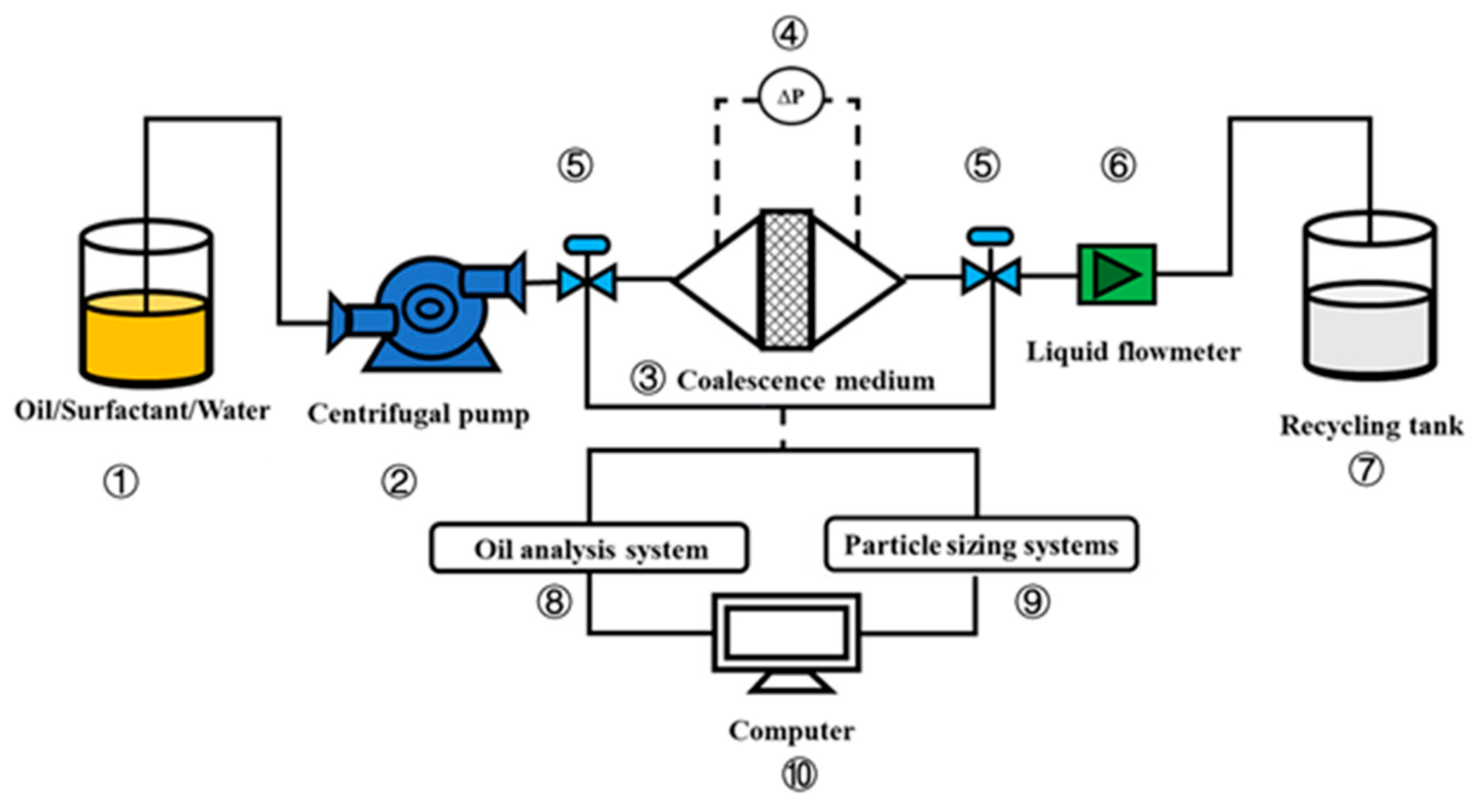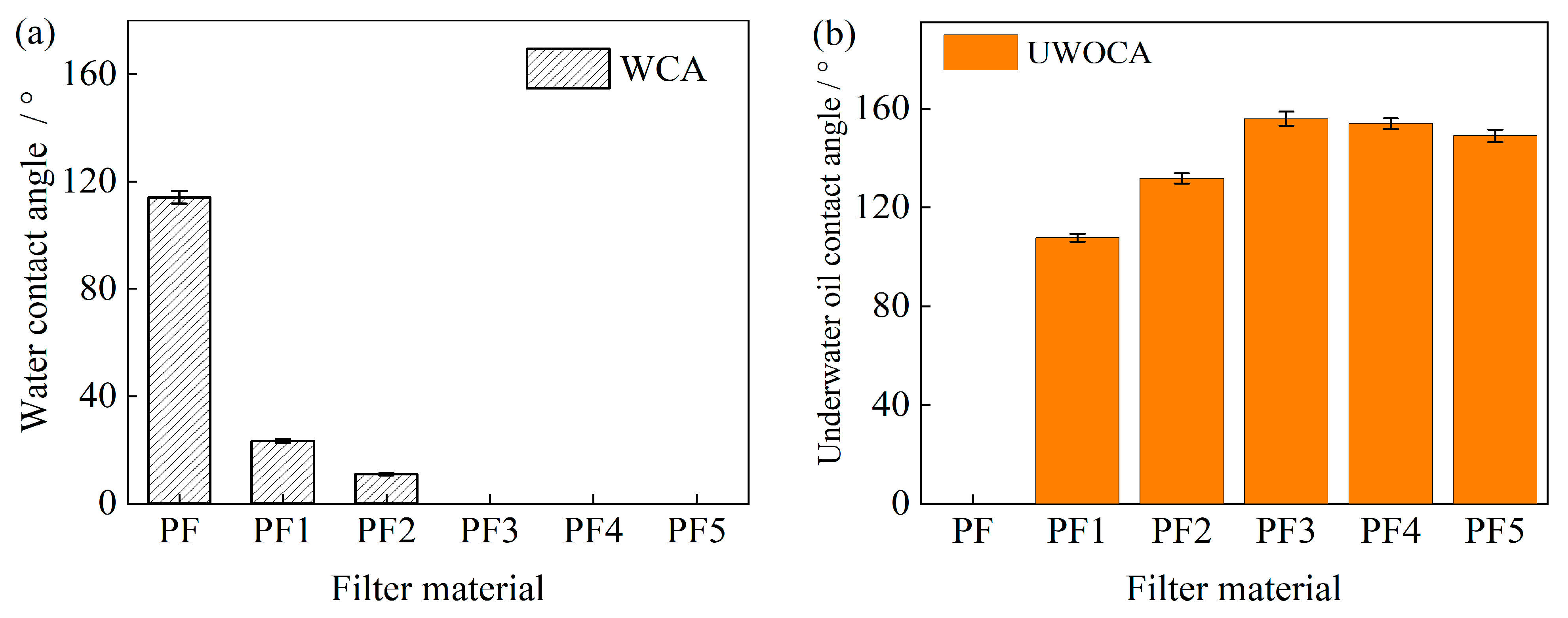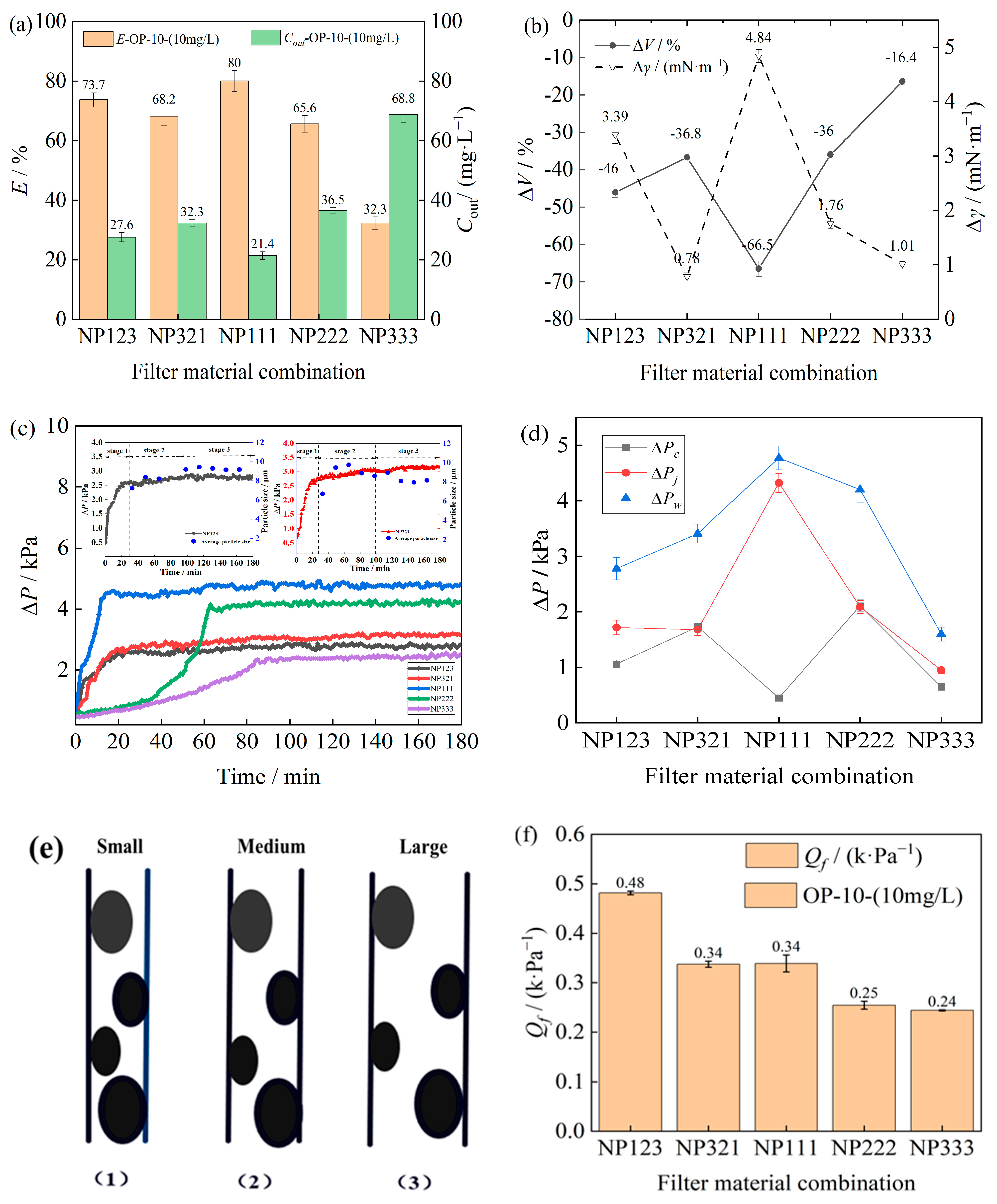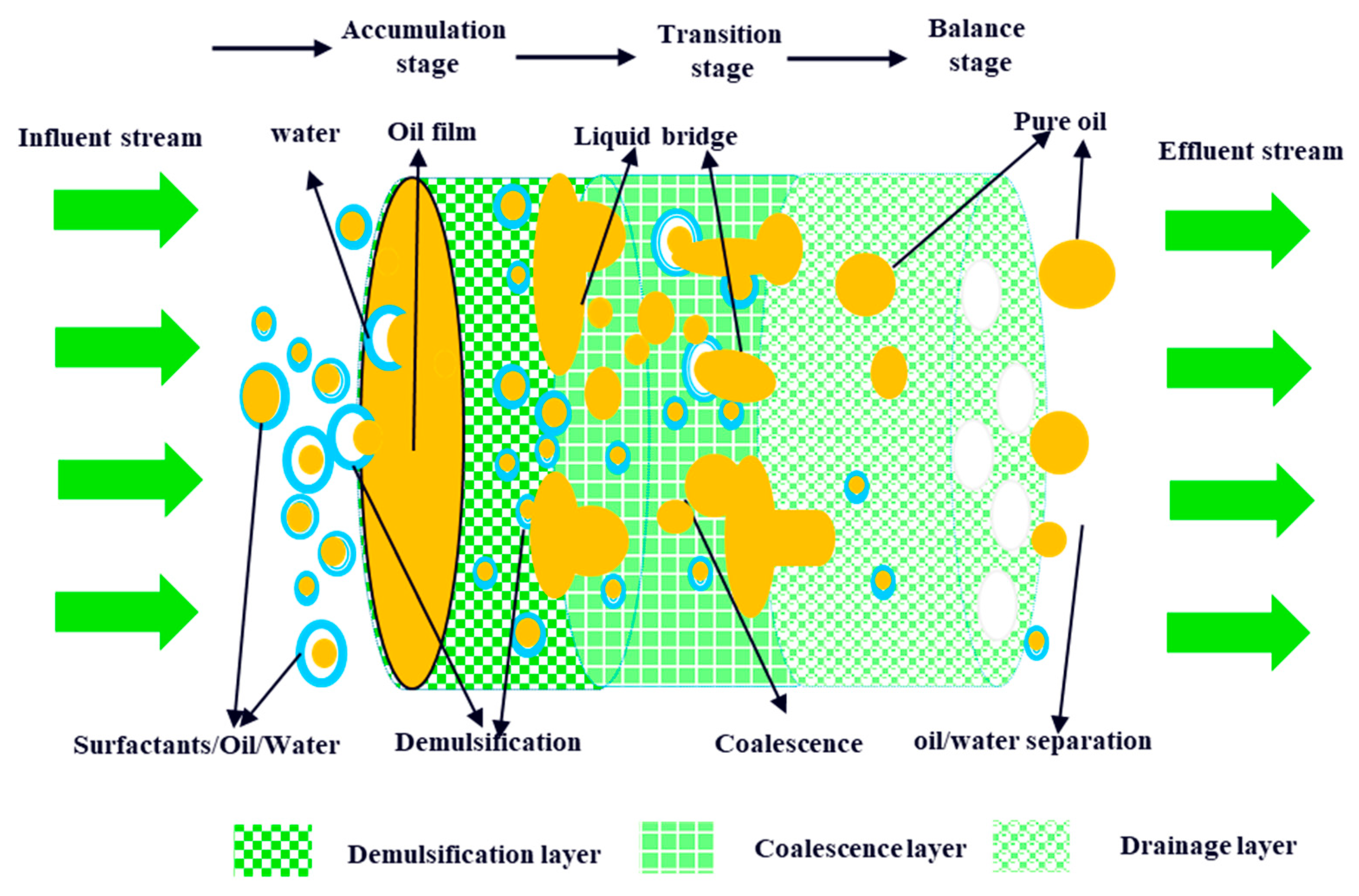Multi-Layer Filter Material with a Superoleophobic Pore Size Gradient for the Coalescence Separation of Surfactant-Stabilized Oil-in-Water Emulsions
Abstract
:1. Introduction
2. Materials and Methods
2.1. Materials
2.2. Preparation and Characterization of Modified Fibrous Filter Materials
2.3. Preparation and Separation of Oil-in-Water Emulsion
3. Results and Discussion
3.1. Characterization of Modified Materials
3.2. Effect of Oleophobic Modification on Separation Performance
3.3. Effect of Pore Size Distribution on Coalescence Separation Performance
3.4. Analysis of Superoleophobic Gradient Properties and Demulsification Mechanism
4. Conclusions
Author Contributions
Funding
Data Availability Statement
Conflicts of Interest
References
- Han, M.; Zhang, J.; Chu, W.; Chen, J.; Zhou, G. Research progress and prospects of marine oily wastewater treatment: A Review. Water 2019, 11, 2517. [Google Scholar] [CrossRef]
- Medeiros, A.D.; Junior, C.J.G.S.S.; Amorim, J.D.P.D.; Durval, I.J.B.; Costa, A.F.D.S.; Sarubbo, L.A. Oily wastewater treatment: Methods, challenges, and trends. Processes 2022, 10, 743. [Google Scholar] [CrossRef]
- Ali, N.; Bilal, M.; Khan, A.; Ali, F.; Ibrahim, M.N.M.; Gao, X.Y.; Zhang, S.Z.; Hong, K.; Iqbal, H.M.N. Engineered hybrid materials with smart surfaces for effective mitigation of petroleum-originated pollutants. Engineering 2021, 7, 1492–1503. [Google Scholar] [CrossRef]
- Faisal, W.; Almomani, F. A critical review of the development and demulsification processes applied for oil recovery from oil in water emulsions. Chemosphere 2022, 291, 99–133. [Google Scholar] [CrossRef]
- Gupta, R.K.; Akhtar, F.; Jinadasa, S.; Paudel, S.R.; Rahman, M.F. Water challenges and solution opportunities in South Asia, a rapidly developing region of the world. Spec. Issue ACS EST Water 2023, 3, 1422–1424. [Google Scholar] [CrossRef]
- Zhao, C.; Zhou, J.; Yan, Y.; Yang, L.; Xing, G.; Li, H.; Wu, P.; Wang, M.; Zheng, H. Application of coagulation/flocculation in oily wastewater treatment: A review. Sci. Total Environ. 2021, 765, 14–27. [Google Scholar] [CrossRef]
- Prakash, R.; Majumder, S.K.; Singh, A. Flotation technique: Its mechanisms and design parameters. Chem. Eng. Process 2018, 127, 249–270. [Google Scholar] [CrossRef]
- Yang, Q.; Lu, H.; Li, Y.D.; Dai, P.Y.; Pang, C.Z. Research progress on the application of coalescence separation technology in oil-containing wastewater treatment. J. Environ. Eng. 2021, 5, 767–781. [Google Scholar] [CrossRef]
- Saravanan, A.; Karishma, S.; Kumar, P.S.; Rangasamy, G. Biodegradation of oil-contaminated aqueous ecosystem using an immobilized fungi biomass and kinetic study. Environ. Res. 2023, 220, 115–125. [Google Scholar] [CrossRef]
- Lu, H.; Pan, Z.; Miao, Z.; Xu, X.; Wu, S.; Liu, Y.; Wang, H.; Yang, Q. Combination of electric field and medium coalescence for enhanced demulsification of oil-in-water emulsion. Chem. Eng. J. Adv. 2021, 6, 100–113. [Google Scholar] [CrossRef]
- Li, B.; Qi, B.; Guo, Z.; Wang, D.; Jiao, T. Recent developments in the application of membrane separation technology and its challenges in oil-water separation: A review. Chemosphere 2023, 327, 13–28. [Google Scholar] [CrossRef] [PubMed]
- Dai, P.; Liu, Y.Q.; Lu, H.; Li, Y.D.; Yang, Q. Produced-water treatment: Application and research of combined fiber coalescence technique in offshore oilfield. Pet. Sci. 2023, 1, 569–576. [Google Scholar] [CrossRef]
- Yu, Y.; Liu, M.; Huang, H.; Zhao, L.; Lin, P.; Huang, S.; Xu, J.; Wang, H.; Wang, L. Low cost fabrication of polypropylene fiber composite membrane with excellent mechanical, superhydrophilic, antifouling and antibacterical properties for effective oil-in-water emulsion separation. React. Funct. Polym. 2019, 142, 15–24. [Google Scholar] [CrossRef]
- Hazlett, R.N. Fibrous bed coalescence of water. Steps in the coalescence process. Ind. Eng. Chem. Fundam. 1969, 8, 625–632. [Google Scholar] [CrossRef]
- Zhang, Q.; Li, L.; Cao, L.; Li, Y.; Li, W. Coalescence separation of oil water emulsion on amphiphobic fluorocarbon polymer and silica nanoparticles coated fiber-bed coalesce. Chin. J. Chem. Eng. 2021, 36, 29–37. [Google Scholar] [CrossRef]
- Gadhave, A.D.; Mehdizadeh, S.N.; Chase, G.G. Effect of pore size and wettability of multilayered coalescing filters on water-in-ULSD coalescence. Sep. Purif. Technol. 2019, 211, 236–248. [Google Scholar] [CrossRef]
- Li, C.; Li, J.; Wang, N.; Zhao, Q.; Wang, P. Status of the treatment of produced water containing polymer in oilfields: A review. J. Environ. Chem. Eng. 2021, 9, 105303. [Google Scholar] [CrossRef]
- Zhang, L.; Zhu, T.; Sun, Y.; Jiang, B. Experimental study of precision-woven fabrics for oil-in-water emulsion coalescence: Operating conditions and oil saturation. J. Dispers. Sci. Technol. 2015, 36, 182–189. [Google Scholar] [CrossRef]
- Huang, H.; Ma, H.; Liu, B.; Yang, S.; Wei, Q.; Zhang, Y.; Lv, W. Bed filtration pressure drop prediction and accuracy evaluation using the Ergun equation with optimized dynamic parameters in industrial wastewater treatment. J. Water Process Eng. 2023, 53, 103776. [Google Scholar] [CrossRef]
- Wang, N.; Wang, Q.; Xu, S.; Zheng, X.; Zhang, M. Facile fabrication of amphiphobic surfaces on copper substrates with a mixed modified solution. RSC Adv. 2019, 9, 17366–17372. [Google Scholar] [CrossRef]
- Li, F.; Wang, Z.; Huang, S.; Pan, Y.; Zhao, X. Flexible, durable, and unconditioned superoleophobic/superhydrophilic surfaces for controllable transport and oil-water separation. Adv. Funct. Mater. 2018, 28, 1706867. [Google Scholar] [CrossRef]
- Yang, J.; Song, H.; Yan, X.; Tang, H.; Li, C. Superhydrophilic and superoleophobic chitosan-based nanocomposite coatings for oil/water separation. Cellulose 2014, 21, 1851–1857. [Google Scholar] [CrossRef]
- Cui, C.; Wang, W.; Lv, X.; Jiao, S.; Pang, G. Fabrication of superwetting non-woven fabric by grafting one-dimensional inorganic nanostructure for efficient separation of surfactant-stabilized organic solvent/water emulsions. Colloids Surf. A Physicochem. Eng. Asp. 2023, 663, 131068. [Google Scholar] [CrossRef]
- Kampa, D.; Wurster, S.; Buzengeiger, J.; Meyer, J.; Kasper, G. Pressure drop and liquid transport through coalescence filter media used for oil mist filtration. Int. J. Multiph. Flow 2014, 58, 313–324. [Google Scholar] [CrossRef]
- Mino, Y.; Hasegawa, A.; Shinto, H.; Matsuyama, H. Lattice-Boltzmann flow simulation of an oil-in-water emulsion through a coalescing filter: Effects of filter structure. Chem. Eng. 2017, 11, 210–217. [Google Scholar] [CrossRef]
- Bansal, S.; Arnim, V.; Stegmaier, T.; Planck, H. Effect of fibrous filter properties on the oil-in-water-emulsion separation and filtration performance. J. Hazard. Mater. 2011, 190, 45–50. [Google Scholar] [CrossRef]
- Pan, Y.L.; Huang, S.; Li, F.; Zhao, X.; Wang, W.J. Coexistence of superhydrophilicity and superoleophobicity: Theory, experiments and applications in oil/water separation. J. Mater. Chem. A 2018, 6, 15057–15063. [Google Scholar] [CrossRef]
- Shin, C. Filtration application from recycled expanded polystyrene. J. Colloid. Interface Sci. 2006, 302, 267–271. [Google Scholar] [CrossRef]
- Brown, R.C. Air Filtration: An Integrated Approach to the Theory and Applications of Fibrous Filters; Pergamon Press: New York, NY, USA, 1993; pp. 1–272. [Google Scholar] [CrossRef]
- Shin, C.; Chase, G.G.; Reneker, D.H. The effect of nanofibers on liquid-liquid coalescence filter performance. AIChE J. 2005, 51, 3109–3113. [Google Scholar] [CrossRef]
- Washburn, E. The dynamics of capillary flow. Phys. Rev. 1921, 17, 273–283. [Google Scholar] [CrossRef]
- Yue, Y.; Hara, M.; Mukai, Y. Continuous coalescence and separation of oil-in-water emulsion via polyacrylonitrile nanofibrous membrane coalesce. Colloids Surf. A Physicochem. Eng. Asp. 2022, 657, 130626. [Google Scholar] [CrossRef]
- Lu, H.; Liu, Y.Q.; Cai, J.B.; Xu, X.; Xie, L.S.; Yang, Q.; Li, Y.X.; Zhu, K. Treatment of offshore oily produced water: Research and application of a novel fibrous coalescence technique. J. Pet. Sci. Eng. 2019, 178, 602–608. [Google Scholar] [CrossRef]
- Gao, S.J.; Zhu, Y.Z.; Zhang, F.; Jin, J. Superwetting polymer-decorated SWCNT composite ultrathin films for ultrafast separa-tion of oil-in-water nanoemulsions. Mater. Chem. A 2015, 3, 2895–2902. [Google Scholar] [CrossRef]
- Hao, S.Y.; He, J.S.; Wang, K.S.; Liu, J.L. experiment research on coalescence treatment of oily waste water by three different material filter. Environ. Eng. 2015, 33, 174–178. (In Chinese) [Google Scholar]
- Zuo, H.Q.; Xie, L.; Li, H.K.; Zhang, Y.B.; Men, L.G. Experimental Study on Separating Oily Wastewater with Coalescing Filters. Chem. Mach. 2012, 39, 575–577. (In Chinese) [Google Scholar]








| Material Type | Thickness/mm | Weight/(g/m2) | Average Pore Size/μm | Underwater Oil Contact Angle/° |
|---|---|---|---|---|
| PP1 | 0.72 ± 0.02 | 171.9 ± 0.9 | 9.82 ± 0.15 | 0 |
| PP2 | 0.69 ± 0.01 | 148.8 ± 0.6 | 15.53 ± 0.13 | 0 |
| PP3 | 0.63 ± 0.01 | 139.1 ± 0.5 | 21.09 ± 0.42 | 0 |
| Material Type | Thickness/mm | Weight/(g/m2) | Average Pore Size/μm | Underwater Oil Contact Angle/° |
|---|---|---|---|---|
| NP1 | 0.75 ± 0.04 | 214.9 ± 2 | 8.16 ± 0.28 | 155.8 ± 2.2 |
| NP2 | 0.72 ± 0.02 | 190.2 ± 1.2 | 14.62 ± 0.60 | 151.2 ± 1.3 |
| NP3 | 0.66 ± 0.01 | 188.4 ± 0.8 | 19.27 ± 0.72 | 149.6 ± 1.8 |
| Filter Material Combination | NP123 | NP321 | NP111 | NP222 | NP333 |
|---|---|---|---|---|---|
| 1st layer (inlet liquid level) | NP1 | NP3 | NP1 | NP2 | NP3 |
| 2nd layer (middle layer) | NP2 | NP2 | NP1 | NP2 | NP3 |
| 3rd layer (liquid outlet) | NP3 | NP1 | NP1 | NP2 | NP3 |
| Material Type | Emulsifier Type | Test Conditions | Cout/(mg·L−1) | ΔP/kPa | References |
|---|---|---|---|---|---|
| Polypropylene fiber | SPAN20 | Cross flow | 95 | 25 | Yue et al. [32] |
| metal and polymer | / | Cross flow | 96–97.5 | 30 | Lu et al. [33] |
| Polydopamine–polyethyleneimine | TWEEN80 | Dead end filtering | <96 | / | Gao et al. [34] |
| Polyester | SDS | Cross flow | 97.2 | 16 | Zhang et al. [18] |
| Stainless steel fiber | SPAN80 | Cross flow | 95.5 | 20 | Hao et al. [35] |
| Glass fiber | OP-10 | Cross flow | >95 | / | Zuo et al. [36] |
| Polypropylene fiber | OP-10 | Cross flow | 93.9 | 5.6 | This work |
| Polypropylene fiber | CTAB | Cross flow | 96.4 | 4.9 | This work |
| Polypropylene fiber | SDS | Cross flow | 97.2 | 10.5 | This work |
Disclaimer/Publisher’s Note: The statements, opinions and data contained in all publications are solely those of the individual author(s) and contributor(s) and not of MDPI and/or the editor(s). MDPI and/or the editor(s) disclaim responsibility for any injury to people or property resulting from any ideas, methods, instructions or products referred to in the content. |
© 2025 by the authors. Licensee MDPI, Basel, Switzerland. This article is an open access article distributed under the terms and conditions of the Creative Commons Attribution (CC BY) license (https://creativecommons.org/licenses/by/4.0/).
Share and Cite
Wu, X.; Wang, Y.; Li, C.; Liu, L.; Li, X.; Chang, C. Multi-Layer Filter Material with a Superoleophobic Pore Size Gradient for the Coalescence Separation of Surfactant-Stabilized Oil-in-Water Emulsions. Processes 2025, 13, 1600. https://doi.org/10.3390/pr13051600
Wu X, Wang Y, Li C, Liu L, Li X, Chang C. Multi-Layer Filter Material with a Superoleophobic Pore Size Gradient for the Coalescence Separation of Surfactant-Stabilized Oil-in-Water Emulsions. Processes. 2025; 13(5):1600. https://doi.org/10.3390/pr13051600
Chicago/Turabian StyleWu, Xingdong, Ying Wang, Chengzhi Li, Lang Liu, Xiaowei Li, and Cheng Chang. 2025. "Multi-Layer Filter Material with a Superoleophobic Pore Size Gradient for the Coalescence Separation of Surfactant-Stabilized Oil-in-Water Emulsions" Processes 13, no. 5: 1600. https://doi.org/10.3390/pr13051600
APA StyleWu, X., Wang, Y., Li, C., Liu, L., Li, X., & Chang, C. (2025). Multi-Layer Filter Material with a Superoleophobic Pore Size Gradient for the Coalescence Separation of Surfactant-Stabilized Oil-in-Water Emulsions. Processes, 13(5), 1600. https://doi.org/10.3390/pr13051600





